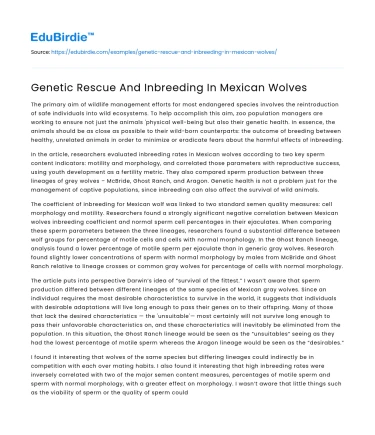The primary aim of wildlife management efforts for most endangered species involves the reintroduction of safe individuals into wild ecosystems. To help accomplish this aim, zoo population managers are working to ensure not just the animals 'physical well-being but also their genetic health. In essence, the animals should be as close as possible to their wild-born counterparts: the outcome of breeding between healthy, unrelated animals in order to minimize or eradicate fears about the harmful effects of inbreeding.
In the article, researchers evaluated inbreeding rates in Mexican wolves according to two key sperm content indicators: motility and morphology, and correlated those parameters with reproductive success, using youth development as a fertility metric. They also compared sperm production between three lineages of grey wolves – McBride, Ghost Ranch, and Aragon. Genetic health is not a problem just for the management of captive populations, since inbreeding can also affect the survival of wild animals.
Save your time!
We can take care of your essay
- Proper editing and formatting
- Free revision, title page, and bibliography
- Flexible prices and money-back guarantee
The coefficient of inbreeding for Mexican wolf was linked to two standard semen quality measures: cell morphology and motility. Researchers found a strongly significant negative correlation between Mexican wolves inbreeding coefficient and normal sperm cell percentages in their ejaculates. When comparing these sperm parameters between the three lineages, researchers found a substantial difference between wolf groups for percentage of motile cells and cells with normal morphology. In the Ghost Ranch lineage, analysis found a lower percentage of motile sperm per ejaculate than in generic gray wolves. Research found slightly lower concentrations of sperm with normal morphology by males from McBride and Ghost Ranch relative to lineage crosses or common gray wolves for percentage of cells with normal morphology.
The article puts into perspective Darwin’s idea of “survival of the fittest.” I wasn’t aware that sperm production differed between different lineages of the same species of Mexican gray wolves. Since an individual requires the most desirable characteristics to survive in the world, it suggests that individuals with desirable adaptations will live long enough to pass their genes on to their offspring. Many of those that lack the desired characteristics — the 'unsuitable'— most certainly will not survive long enough to pass their unfavorable characteristics on, and these characteristics will inevitably be eliminated from the population. In this situation, the Ghost Ranch lineage would be seen as the “unsuitables” seeing as they had the lowest percentage of motile sperm whereas the Aragon lineage would be seen as the “desirables.”
I found it interesting that wolves of the same species but differing lineages could indirectly be in competition with each over mating habits. I also found it interesting that high inbreeding rates were inversely correlated with two of the major semen content measures, percentages of motile sperm and sperm with normal morphology, with a greater effect on morphology. I wasn’t aware that little things such as the viability of sperm or the quality of sperm could be counted as measure for “reproductive success” but nevertheless, I enjoyed the article and it was an interesting read.
Did you like this example?
Make sure you submit a unique essay
Our writers will provide you with an essay sample written from scratch: any topic, any deadline, any instructions.
Cite this paper
-
APA
-
MLA
-
Harvard
-
Vancouver
Genetic Rescue And Inbreeding In Mexican Wolves.
(2022, February 27). Edubirdie. Retrieved April 4, 2025, from https://hub.edubirdie.com/examples/genetic-rescue-and-inbreeding-in-mexican-wolves/
“Genetic Rescue And Inbreeding In Mexican Wolves.” Edubirdie, 27 Feb. 2022, hub.edubirdie.com/examples/genetic-rescue-and-inbreeding-in-mexican-wolves/
Genetic Rescue And Inbreeding In Mexican Wolves. [online].
Available at: <https://hub.edubirdie.com/examples/genetic-rescue-and-inbreeding-in-mexican-wolves/> [Accessed 4 Apr. 2025].
Genetic Rescue And Inbreeding In Mexican Wolves [Internet]. Edubirdie.
2022 Feb 27 [cited 2025 Apr 4].
Available from: https://hub.edubirdie.com/examples/genetic-rescue-and-inbreeding-in-mexican-wolves/
copy






 Stuck on your essay?
Stuck on your essay?

